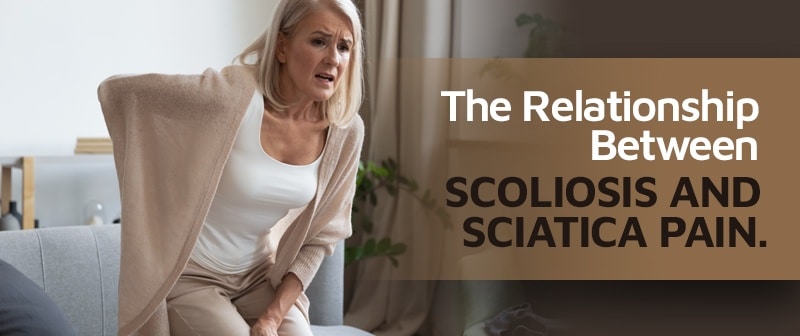
Scoliosis is a spinal condition that leads to a curvature that can cause pinching and constriction along the vertebrae.
Sciatic pain is a source of extreme discomfort and sensitivity along the sciatic nerve. This nerve starts in the lower lumbar spine, leading down near the heel of both legs.
So, what is the relationship between scoliosis and sciatic pain? Since scoliosis pinches and compresses the spine indirectly through unnatural curvature, it can squeeze the sciatic nerve. This squeezing produces troubling sciatic pain that can often be debilitating for people who have scoliosis.

The symptoms of sciatic nerve pain can be similar to the symptoms of scoliosis. If you want to learn the causes, symptoms, and treatments of scoliosis and sciatic nerve pain, read on.
The relationship between scoliosis and sciatic pain is a rather clear one. Scoliosis curves the spine at awkward angles, putting immense pressure on random areas throughout the back. If this area happens to be on or near the sciatic nerve, it can cause sciatic pain.
Sciatic pain caused by scoliosis is more common in patients who are 30 years of age or older. This increased likelihood of pain exists because the spine in older people is fully developed, meaning small changes can cause sudden and unexpected results. When the spine doesn’t continue growing or moving, it settles right onto the nerve, causing the pain.
However, sciatic nerve pain isn’t exclusive to adults. Adolescents with a growing spine can have a pinched nerve that seemingly forms overnight if they already have a spinal curvature present. Fortunately, it can be treated at this age through chiropractic examinations, tests, and adjustments that tend to work quicker on young patients.

People of all ages can experience a pinched sciatic nerve caused by the natural progression of scoliosis. Once the nerve is pinched, there are plenty of uncomfortable symptoms that the patient can experience. Proper treatment is the key to relief, which means someone suffering from sciatic nerve pain should seek professional medical help as soon as possible.
There are many causes of sciatic pain other than scoliosis. These causes include the following:
As the sciatic nerve runs from the lower back to the bottom of both legs, the pain usually centers in these areas. The severity of the pain varies from case to case, but it’s generally known as one of the most debilitating nerve issues in the back. The mobility of patients suffering from this pain can be limited, even when doing simple tasks.
Sciatic nerve pain and damage - whether it’s caused by scoliosis or not - can cause severe disability. Fortunately, there are a number of reliable treatments in the medical industry.
As with all problems caused by scoliosis, it’s easier to treat these problems and even rid them entirely if you can catch them before they get too severe.
Various treatments can lead to the relief of pain caused by sciatic nerve damage.
In most cases, sciatic nerve pain is much simpler to treat when the pain is caused by scoliosis, since a surgical procedure usually isn’t required.
Once a doctor or another medical professional determines that scoliosis is the cause of the nerve pain, they can move forward to a set of four common treatments.
Keep in mind that pain medication is never a cure on its own. In fact, it can mask the symptoms to make the patient think that the issue is gone when it’s actually growing even worse.
While medication might be part of the treatment process to help ease the pain, it is never going to correct the spinal misalignment and curvature caused by scoliosis.

The vertebra that the scoliosis impacts determines where you feel pain.
For example, the knee can have severe pain if the L3 on your spine is affected by scoliosis. L4 generally sends pain to the top of the foot, and L5 causes issues with the feet and calves alike.
The nervous system follows a path that goes downward, which is why you won’t typically experience sciatic pain in the upper body. It can lead to other nerve damage that might eventually progress upward, though.
There is a clear relationship between sciatic pain and scoliosis. Scoliosis can curve the spine at various angles, some of which can place pressure on the sciatic nerve. This pressure can cause sciatic nerve pain.
Sciatic nerve pain can present in a variety of ways:
Fortunately, there are a variety of treatments that can help with sciatic nerve pain caused by scoliosis. Chiropractic adjustments, exercises and stretches, back braces, and medication can all provide relief to patients suffering from scoliosis-induced sciatic pain.
If you’re experiencing sciatic nerve pain, talk to your doctor and ask if scoliosis is a potential cause. If it is, you’ll want to treat it immediately to relieve your pain and prevent further degeneration of the spine.
At CLEAR Scoliosis Institute we can can provide information about a treatment plan that would be best for you. For more information, please contact a CLEAR Certified Doctor. We look forward to hearing from you.

CLEAR provides a unique and innovative way of understanding scoliosis. Sign up to receive facts and information you won’t find anywhere else.

82 YEARS. HAVE SCOLIOSIS, SCIATICA, ARTHRITIS, VERTIGO. HAD 6 EPIDURAL INJECTIOS AT HACKENSACK MEDICAL GRP NJ AND NYU LANGONE NYC, STILL NO REAL RELIEF !!!
IS "RADIOFREQUENCY ABLATION" A POSSIBILITY FOR NON INVASIE PROCEDURE ????
ALSO HAD PHYSICAL THERAPY AT KESSLER AND HACKENSACK AND CHIROPACTIC SESSIONS IN THE PAST. ALSO, IS "ACCUPUNCTURE" A POSSIBILITY ????
AT A TOTAL LOSS, WHAT TO DO. ALL MY DOCTORS KNOW THIS INFO !!!!
ANY GOOD MEDICATION BESIDES TYLENOL ??????
Hello, Frank,
I am sorry to hear of what you must be dealing with on a daily basis. I imagine it is getting frustrating. Regarding the scoliosis, the neck issues, and arthritic symptoms, our CLEAR Scoliosis Institute certified Doctors specialize in care to reduce and stabilize the scoliosis to improve range of motion and decrease pain. I suggest contacting our nearest clinic to determine if you would be a candidate for care. You, of course, can try different therapies and see if they help reduce symptoms; however, addressing the root cause and treating the scoliosis may have a more effective result. To find the nearest one of our clinics, please visit our website under Find a Doctor. Please let us know if we can be of further assistance. Best of luck to you.